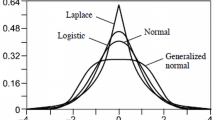Abstract
If customary methods of solution are used on the method of paired comparisons for Thurstone's Case V (assuming equal standard deviations of sensations for each stimulus), when in fact one or more of the standard deviations is aberrant, all stimuli will be properly spaced except the one with the aberrant standard deviation. A formula is given to show the amount of error due to the aberrant stimulus.
Similar content being viewed by others
Author information
Authors and Affiliations
Additional information
This research was performed in the Laboratory of Social Relations under a grant made available to Harvard University by the RAND Corporation under the Department of the Air Force, Project RAND.
Rights and permissions
About this article
Cite this article
Mosteller, F. Remarks on the method of paired comparisons: II. The effect of an aberrant standard deviation when equal standard deviations and equal correlations are assumed. Psychometrika 16, 203–206 (1951). https://doi.org/10.1007/BF02289115
Received:
Issue Date:
DOI: https://doi.org/10.1007/BF02289115




